Pi Cassiopeiae
Pi Cassiopeiae, Latinized from π Cassiopeiae, is a close binary star[8] system in the constellation Cassiopeia. It is visible to the naked eye with an apparent visual magnitude of +4.949.[2] Based upon an annual parallax shift of 18.63 mas as seen from Earth,[1] this system is located about 175 light years from the Sun.

This is a double-lined spectroscopic binary system with an orbital period of nearly two days in a circular orbit.[8] It is classified as a rotating ellipsoidal variable star and its brightness varies by 0.02 magnitudes with a period of 23.57 hours,[5] which equals half of its orbital period. The spectrum matches that of an A-type main-sequence star with a stellar classification of A5 V.[3] The two stars have similar masses and spectra.[4] A star at a projected separation of 1,700 AU has been identified as a possible white dwarf. It is at the same distance as Pi Cassiopeiae and shares a common proper motion. The age of the white dwarf is calculated to be about 500 million years.[14]
Pi Cassiopeiae has been given the spectral class of kA3hF1mA5, indicating an Am star,[15] but this is now considered doubtful.[16]
References
- ^ a b c d e f van Leeuwen, F. (2007), "Validation of the new Hipparcos reduction", Astronomy and Astrophysics, 474 (2): 653–664, arXiv:0708.1752, Bibcode:2007A&A...474..653V, doi:10.1051/0004-6361:20078357, S2CID 18759600.
- ^ a b c Høg, E.; et al. (2000), "The Tycho-2 catalogue of the 2.5 million brightest stars", Astronomy and Astrophysics, 355: L27, Bibcode:2000A&A...355L..27H, doi:10.1888/0333750888/2862.
- ^ a b Cowley, A.; et al. (April 1969), "A study of the bright A stars. I. A catalogue of spectral classifications", Astronomical Journal, 74: 375–406, Bibcode:1969AJ.....74..375C, doi:10.1086/110819.
- ^ a b c d e f Howe, K. S.; Clarke, C. J. (2009). "An analysis of v sin (I) correlations in early-type binaries". Monthly Notices of the Royal Astronomical Society. 392 (1): 448. Bibcode:2009MNRAS.392..448H. doi:10.1111/j.1365-2966.2008.14073.x. S2CID 120183969.
- ^ a b Samus, N. N.; et al. (2017), "General Catalogue of Variable Stars", Astronomy Reports, GCVS 5.1, 61 (1): 80–88, Bibcode:2017ARep...61...80S, doi:10.1134/S1063772917010085, S2CID 125853869.
- ^ de Bruijne, J. H. J.; Eilers, A.-C. (October 2012), "Radial velocities for the HIPPARCOS-Gaia Hundred-Thousand-Proper-Motion project", Astronomy & Astrophysics, 546: 14, arXiv:1208.3048, Bibcode:2012A&A...546A..61D, doi:10.1051/0004-6361/201219219, S2CID 59451347, A61.
- ^ Anderson, E.; Francis, Ch. (2012), "XHIP: An extended hipparcos compilation", Astronomy Letters, 38 (5): 331, arXiv:1108.4971, Bibcode:2012AstL...38..331A, doi:10.1134/S1063773712050015, S2CID 119257644.
- ^ a b c Pourbaix, D.; et al. (2004), "SB9: The Ninth Catalogue of Spectroscopic Binary Orbits", Astronomy & Astrophysics, 424: 727–732, arXiv:astro-ph/0406573, Bibcode:2004A&A...424..727P, doi:10.1051/0004-6361:20041213, S2CID 119387088.
- ^ a b Vallenari, A.; et al. (Gaia collaboration) (2023). "Gaia Data Release 3. Summary of the content and survey properties". Astronomy and Astrophysics. 674: A1. arXiv:2208.00211. Bibcode:2023A&A...674A...1G. doi:10.1051/0004-6361/202243940. S2CID 244398875. Gaia DR3 record for this source at VizieR.
- ^ McDonald, I.; et al. (2012), "Fundamental Parameters and Infrared Excesses of Hipparcos Stars", Monthly Notices of the Royal Astronomical Society, 427 (1): 343–57, arXiv:1208.2037, Bibcode:2012MNRAS.427..343M, doi:10.1111/j.1365-2966.2012.21873.x, S2CID 118665352.
{{citation}}: CS1 maint: unflagged free DOI (link) - ^ a b c David, Trevor J.; Hillenbrand, Lynne A. (2015), "The Ages of Early-Type Stars: Strömgren Photometric Methods Calibrated, Validated, Tested, and Applied to Hosts and Prospective Hosts of Directly Imaged Exoplanets", The Astrophysical Journal, 804 (2): 146, arXiv:1501.03154, Bibcode:2015ApJ...804..146D, doi:10.1088/0004-637X/804/2/146, S2CID 33401607.
- ^ "pi. Cas". SIMBAD. Centre de données astronomiques de Strasbourg. Retrieved 2017-08-30.
- ^ "MAST: Barbara A. Mikulski Archive for Space Telescopes". Space Telescope Science Institute. Retrieved 8 December 2021.
- ^ Qiu, Dan; Tian, Hai-Jun; Wang, Xi-Dong; Nie, Jia-Lu; von Hippel, Ted; Liu, Gao-Chao; Fouesneau, Morgan; Rix, Hans-Walter (2021). "Precise Ages of Field Stars from White Dwarf Companions in Gaia DR2". The Astrophysical Journal Supplement Series. 253 (2): 58. arXiv:2012.04890. Bibcode:2021ApJS..253...58Q. doi:10.3847/1538-4365/abe468. S2CID 234867350.
- ^ Abt, Helmut A.; Morrell, Nidia I. (1995). "The Relation between Rotational Velocities and Spectral Peculiarities among A-Type Stars". Astrophysical Journal Supplement Series. 99: 135. Bibcode:1995ApJS...99..135A. doi:10.1086/192182.
- ^ Renson, P.; Manfroid, J. (2009). "Catalogue of Ap, HGMN and Am stars". Astronomy and Astrophysics. 498 (3): 961. Bibcode:2009A&A...498..961R. doi:10.1051/0004-6361/200810788.

